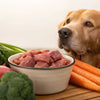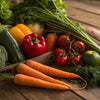How Many Ounces of Raw Food to Feed Your Dog: A Comprehensive Guide
- Houndsy
Table of Contents
- Introduction
- Understanding Raw Dog Food Diets
- How Much Raw Food to Feed Based on Weight and Activity Level
- Influences on Feeding Amounts
- Practical Conversion Calculations
- The Importance of Houndsy Kibble Dispenser
- Conclusions
- FAQ Section
Introduction
Did you know that over 70% of dog owners express uncertainty about how much to feed their pets? As loving pet owners, we want to ensure our four-legged companions lead healthy and happy lives. A critical part of achieving this is understanding their dietary needs, especially when it comes to raw feeding. The question of "how many ounces of raw food to feed a dog" isn’t just a numbers game; it involves considering numerous factors, including our dog's size, age, activity level, and health condition.
In this blog post, we will delve into the intricacies of raw feeding, exploring how different factors affect the quantity of food your dog should receive. We aim to provide you with clear guidance, nutritional insights, and practical tips to help you make informed decisions, enhancing our dogs' feeding experience. By the end of this article, you'll have a comprehensive understanding of how to determine the right amount of raw food for your dog, ensuring their well-being and vitality.
To set our expectations, we will cover the following key areas:
- Understanding the basics of raw dog food diets
- How much raw food to feed based on weight and activity levels
- The impact of age, breed, and special circumstances on feeding needs
- Practical conversion calculations to guide your feeding regimen
- The benefits of using innovative tools like the Houndsy Kibble Dispenser to simplify meal-serving processes
With this knowledge, we can foster healthier feeding routines, combining practicality with the elegance of good design through our flagship product, the Houndsy Kibble Dispenser, which helps elevate the everyday activity of feeding our beloved dogs.
Understanding Raw Dog Food Diets
The Concept of Raw Feeding
Raw feeding, often referred to as a "biologically appropriate raw food" (BARF) diet, focuses on offering dogs a diet closer to what their ancestors would have eaten. This includes raw meat, organs, and bones, supplemented with vegetables and fruits, catering to their carnivorous instincts. Advocates of raw feeding assert that it can lead to improved coat condition, enhanced digestion, and optimal energy levels.
Nutritional Needs of Dogs
Dogs, like us, require a balanced diet—one composed of proteins, fats, carbohydrates, vitamins, and minerals. The essential nutrients for dogs are:
- Proteins: Necessary for growth, maintenance, and energy. Raw meats (such as chicken, beef, lamb) are excellent sources.
- Fats: Provide energy and support the absorption of fat-soluble vitamins, along with skin and coat health.
- Carbohydrates: Found in fruits and vegetables, they provide fiber along with some essential vitamins and minerals.
Understanding these nutritional needs is crucial when determining the right balance and amount of raw food your dog should consume.
How Much Raw Food to Feed Based on Weight and Activity Level
Daily Feeding Guidelines
The general rule of thumb for adult dogs is to feed them between 2% to 4% of their ideal body weight daily. However, this percentage can vary based on several factors, including age, activity level, and metabolic rate. Here’s how to break it down:
-
Adult Dogs
-
Weight: As a starting point, use the following percentages:
- Low activity level: 2%
- Moderate activity level: 2.5% to 3%
- High activity level: 3.5% to 4%
- For example, a 50-pound dog on a moderate activity level might require approximately 1.25 to 1.5 pounds of raw food daily (which equates to around 20 to 24 ounces).
-
Weight: As a starting point, use the following percentages:
-
Puppies
- Puppies typically require more food based on their rapid growth and energy needs. They should be fed between 4% to 6% of their current body weight. An 8-pound puppy may need about 6.4 to 9.6 ounces of food daily, divided into multiple meals throughout the day.
-
Senior Dogs
- Senior dogs may require slightly less food to maintain an ideal weight due to reduced activity levels, often around 1.5% to 2% of their body weight.
Conversion to Ounces
To convert feeding guidelines into ounces, remember:
- 1 pound = 16 ounces
Here’s a simplified table for reference:
| Dog Weight | 2% (Low Activity) | 2.5% (Moderate Activity) | 3% (High Activity) |
|---|---|---|---|
| 10 lbs | 3.2 oz | 4 oz | 4.8 oz |
| 25 lbs | 8 oz | 10 oz | 12 oz |
| 50 lbs | 1 lb (16 oz) | 1.25 lbs (20 oz) | 1.5 lbs (24 oz) |
| 100 lbs | 2 lbs (32 oz) | 2.5 lbs (40 oz) | 3 lbs (48 oz) |
Influences on Feeding Amounts
Age and Activity Level
Every dog is unique. Puppies, active dogs, and older canines all have distinct dietary needs. It's essential to adapt feeding amounts according to their life stages. Puppies will naturally consume more due to their growth phases, while older dogs typically require less food to avoid obesity.
Breed Considerations
Different dog breeds also have varying metabolic rates. Smaller breeds tend to consume a higher percentage of their body weight than larger breeds. For instance, a Chihuahua may need more food proportionately than a Great Dane.
Health Factors
If your dog has any health issues, such as obesity or diabetes, consulting with a veterinarian for tailored feeding advice is essential. Special dietary needs may necessitate specific meal plans to manage health concerns.
Practical Conversion Calculations
The Easy Way to Calculate Daily Intake
When determining how many ounces of raw food to feed your dog, the best approach is:
- Calculate your dog’s ideal weight and determine its percentage based on activity level.
- Convert this into ounces.
For example, if your dog weighs 60 lbs and has a moderate activity level:
- 60 lbs * 0.025 = 1.5 lbs (which equals 24 oz) of raw food daily.
Using a Raw Feeding Calculator
Utilizing a raw feeding calculator can streamline this process, allowing you to input your dog's specifics, such as weight and age, for accurate recommendations. This tool can provide valuable insights without complex calculations, ensuring feeding is straightforward and efficient.
The Importance of Houndsy Kibble Dispenser
As pet parents, we strive to make the feeding process as convenient and enjoyable as possible. Our flagship product, the Houndsy Kibble Dispenser, is designed to address common feeding challenges. With its mid-century modern appeal, it seamlessly fits into your home decor while providing practical features such as:
- Convenience: The crank mechanism allows for easy dispensing at standing height, eliminating the need for bending and ensuring a smooth feeding experience.
- Portion Control: No more guessing how much to feed! You can deliver perfect portions every time, ensuring your dog maintains a healthy diet.
- Flexible Storage: Capable of holding 25–30 lbs of food, the dispenser ensures freshness with its BPA-free liner and auto-locking mechanism that prevents accidental spills by curious pets or toddlers.
If you want to elevate your feeding routine and simplify the process, we invite you to learn more about our innovative Kibble Dispenser by visiting the Houndsy Kibble Dispenser product page.
Conclusions
Achieving a well-balanced diet for your dog through raw feeding is not just about tossing some food into a bowl. It's a calculated approach that considers multiple factors to provide the best for our furry friends. By understanding how much raw food to feed your dog based on their size, activity levels, age, and breed, we can increase their well-being and happiness.
Utilizing tools like the Houndsy Kibble Dispenser not only simplifies feeding time but also enhances our overall experience as pet owners. It aligns with our mission to elevate the dog-feeding process—making it convenient, reliable, and beautiful.
As we continue to navigate our dogs' nutrition, we encourage you to reflect on your current feeding routine and consider how you can adjust it for optimal health. What insights have you gathered about your dog’s eating habits? How might a tool like the Houndsy Kibble Dispenser enhance your daily routine? Conclusively, empowered with knowledge and innovative tools, let’s make the feeding experience a joyful one for both us and our beloved canine companions.
FAQ Section
1. How do I calculate the amount of raw food for my dog?
To determine how many ounces of raw food to feed your dog, calculate based on their weight and activity level. For adult dogs, figure between 2% to 4% of their weight daily, and for puppies, increase to 4% to 6%. Convert this into ounces for practical application.
2. Can I mix raw food with kibble?
Yes, many pet parents choose to mix raw food with kibble. However, ensure you transition slowly to avoid digestive issues and consult your veterinarian for specific dietary recommendations.
3. What factors influence how much I should feed my dog?
Factors such as weight, age, activity level, breed, and health status all influence dietary needs. It's essential to consider each of these aspects for a proper feeding regimen.
4. How can I simplify meal prep for my dog?
Using the Houndsy Kibble Dispenser can help simplify your feeding process. It allows for easy dispensing, portion control, and integrated storage solutions.
5. What are the benefits of raw feeding?
Raw feeding can lead to improved coat condition, better digestion, and higher energy levels. Plus, the natural ingredients can be beneficial for overall health.
For more information on enhancing your pet's feeding experience, visit our product page for the Houndsy Kibble Dispenser here. Let's elevate our dog feeding practices together!













